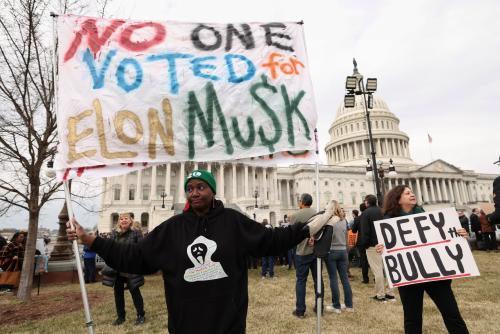Under the Trump administration, the IRS is preparing to reduce its workforce by as much as 50%, according to recent reports. The proposal is unprecedented in its scope and would have untold effects on the reliability of federal revenue if enacted. The startling news comes on the heels of the administration firing nearly 7% of the IRS workforce in the middle of tax season—a decision seven former IRS commissioners, who served under every president since Reagan, have described as “a huge mistake.” As we outline in a new report, it is clear what an underfunded IRS means: an agency unequipped to enforce tax laws on the wealthy or assist honest everyday taxpayers.
What do we know about the mass layoffs that have already occurred? Not nearly enough. Like many recent actions by the administration, the firings were chaotic, open to legal challenge, and opaque. This lack of transparency is a massive problem for democratic accountability. Reportedly, 5,000 of those employees worked in compliance, but some employees modernizing IRS technology and working at call centers were also fired. The termination email stated that the employees were “not deemed as critical” to this filing season. There is little reason for confidence in that judgment. Only a few weeks ago, the administration tried to fire workers responsible for securing our nuclear arsenal.
Other recent actions from the administration are also affecting the IRS workforce. First, a January executive order indefinitely froze IRS hiring. That means the IRS currently cannot replace workers leaving the service. About 63% of the IRS workforce will be retirement-eligible in the next six years, and IRS customer service positions had an attrition rate of 19% in the last fiscal year. Second, IRS employees were among those who received an email asking what they had done in the last week. President Trump, Elon Musk, the Office of Personnel Management, and an official at Treasury provided conflicting information about if a failure to respond would be taken as a resignation. Third, the Department of Homeland Security has sought to divert IRS Criminal Investigation agents into immigration enforcement. As our colleagues Elaine Maag and Diana Guelespe have noted, this deputization could take resources from investigating financial crimes.
Broadly speaking, these decisions affect two key IRS functions: enforcement and taxpayer services. The result will be lower tax compliance and a more frustrating tax season for taxpayers.
First, workforce cuts weaken enforcement capacity. Many recent IRS hires have been under a Biden-era initiative to ramp up audits of high earners. Layoffs of probationary hires may therefore disproportionately affect those efforts. The bottom line: A starving IRS is a feast for wealthy tax evaders. Most of the 600 billion dollars in taxes owed but not paid—the “tax gap”—is due to underreporting of income by high-income taxpayers. Audits of these wealthy taxpayers require more resources than audits of low-income taxpayers. When the government underfunds and understaffs the IRS, they don’t have as much capacity to audit rich tax evaders with high-priced tax lawyers.
That reduction in auditing capacity is a disaster for revenue. It’s called the Internal Revenue Service for a reason—cutting the IRS is synonymous with cutting government revenue. This fact is especially true for audits at the top of the income range. The IRS brings in more than $4 for every $1 spent auditing the top 1% of earners and $6 for every $1 spent auditing the top 0.1%. When accounting for deterrence effects, every additional $1 spent on auditing the top 10% brings in around $12 in revenue.
Second, cuts degrade taxpayer services. When underfunding gutted the IRS in the 2010s, the agency was losing on average about 2% of its workforce a year. The agency stopped having enough staff to answer calls from taxpayers—even those who were facing identity theft. Customer service at the IRS improved markedly after an influx of funding from the Inflation Reduction Act allowed the agency to rebuild its workforce and technology. But now much of that progress is being undone. The administration plans on closing over a hundred IRS offices with taxpayer assistance centers that provide in-person help to taxpayers.
Of course, the recent cuts are on a different order from those the IRS has weathered in the past—never mind the latest news of a potential 50% reduction in force. Increasing uncertainty about federal revenue collection, particularly in the leadup to a debt ceiling fight, is economic malpractice.
So, what should taxpayers do this season? File early and file electronically. Taxpayers can still use the excellent Direct File system that the IRS piloted last year, which provides free electronic filing to taxpayers. About 30 million taxpayers in 25 states qualify to use Direct File, and the response from users has been overwhelmingly positive. The program is a great example of how the civil service can make government work for people… when it is allowed to.
Editor’s Note: The article refers to an IRS service for taxpayers “who were facing identity theft.” The phone service referenced in that sentence is for people whose tax returns are suspended because the IRS suspects identity theft.
The Brookings Institution is committed to quality, independence, and impact.
We are supported by a diverse array of funders. In line with our values and policies, each Brookings publication represents the sole views of its author(s).









Commentary
A hamstrung IRS is a gift to rich tax cheats and a headache for honest taxpayers
March 6, 2025